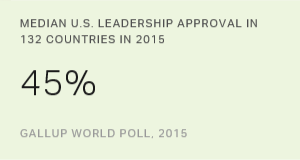Story Highlights
- Rating in Russia is lowest in a decade for U.S.
- Median approval stable at 45% worldwide
- Image of U.S. leadership improves in Europe, the Americas
WASHINGTON, D.C. -- Just 1% of Russians approved of U.S. leadership in 2015 -- the worst rating in the world last year and the lowest approval Gallup has measured for the U.S. in the past decade. Remarkably, this is even worse than their previous record-low 4% approval in 2014.
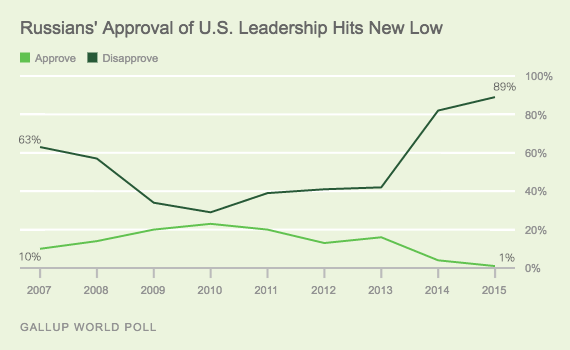
The current record-low rating of 1% in Russia reflects the increasingly tense relations with the U.S. since the crisis in Ukraine and the threat that many Russians, as well as residents of several former Soviet states, feel the U.S. now poses to their countries. In fact, Commonwealth of Independent State (CIS) countries again dominated the list of least-approving countries in 2015, with ratings also in the single digits in Belarus (9%) and Kazakhstan (8%). The only non-CIS country or region at the bottom of the list is the Palestinian Territories (9%).
These results are based on Gallup surveys in 132 countries and areas in 2015 and are further detailed in the new 2016 U.S.-Global Leadership Report.
U.S. Leadership Approval Largely Stable Between 2014 and 2015
Most of the world does not necessarily share as strong distaste for U.S. leadership. Approval of U.S. leadership remained steady worldwide in the second-to-last year of President Barack Obama's second term, with median approval standing at 45% across 132 countries and areas.

The image of U.S. leadership -- which for most of the world likely means Obama -- continued to be the strongest worldwide in Africa in 2015, bolstered by majority approval in 19 sub-Saharan African countries. However, median approval remained unchanged at 59% -- still the lowest point in the history of the trend. This marks the end of a downward trend every year since Obama took office.

Only in Somalia, Tunisia, Morocco and Egypt were residents more likely to disapprove than approve of U.S. leadership. Approval in Africa was lowest in Egypt (10%), which has typically ranked toward the bottom of the list every year. However, Egyptians' approval ratings declined 10 percentage points between 2014 and 2015. The current rating is notably now the lowest measured during the Obama administration and is a full 20 points lower than when he first took office. But the lowest approval ever measured in Egypt still belongs to the previous administration -- 6% in the last year of the George W. Bush presidency.
Approval Steady in Asia
Although the U.S. and 11 Pacific Rim countries finally reached a deal in late 2015 on the Trans-Pacific Partnership, the image of U.S. leadership did not appear to benefit much in the Asia-Pacific region -- with perhaps the exception of Malaysia, which led the world with a 27-point increase in approval. Nor did it benefit much from reaching a nuclear deal with Iran. In fact, the 38% median approval in 2015 is essentially unchanged from 2014.
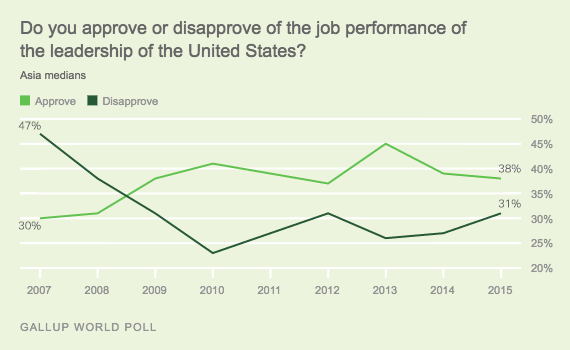
In addition to Malaysia, approval ratings also increased by 10 points or more in Sri Lanka, where fieldwork overlapped with Secretary of State John Kerry's historic visit there -- the first by a U.S. secretary of state in decades. Sri Lankans' approval ratings rose from 17% to 27%, but the majority (63%) still don't know enough about U.S. leadership to have an opinion.
U.S. Image Continues to Improve in Americas
While the image of the U.S. remained largely unchanged in Africa and Asia, the 47% median approval rating for U.S. leadership in the Americas reached its highest point in the past five years. Although approval ratings did not increase dramatically in any country -- with the exception of a 15-point increase in Uruguay -- ratings moved in a positive direction in the majority of countries in the region.
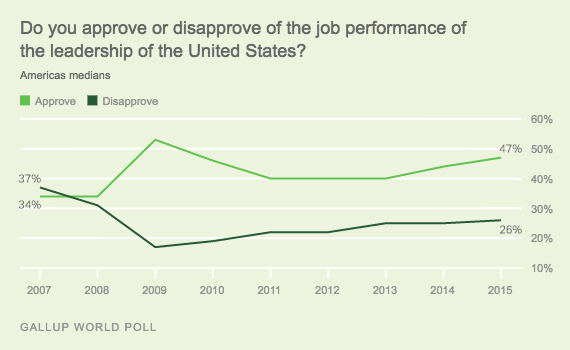
Only in Argentina were residents more likely to disapprove (40%) than approve (24%) of U.S. leadership. But this could someday change. There are signs that years of icy relations between the U.S. and Argentina are beginning to thaw with the election of President Mauricio Macri in late 2015. In early 2016, Obama became the first president to visit Argentina in decades.
Approval Also Up in Europe
Ratings of U.S. leadership have improved in Europe as the region has recovered from the financial crisis that many residents blamed on the U.S. The 46% median approval rating in 2015 has almost rebounded to the level when Obama took office in 2009. Disapproval, however, has not receded. The 35% median disapproval rating in Europe is the highest recorded during the Obama administration, but this is still far lower than the majority disapproval observed during the last years of the George W. Bush administration.
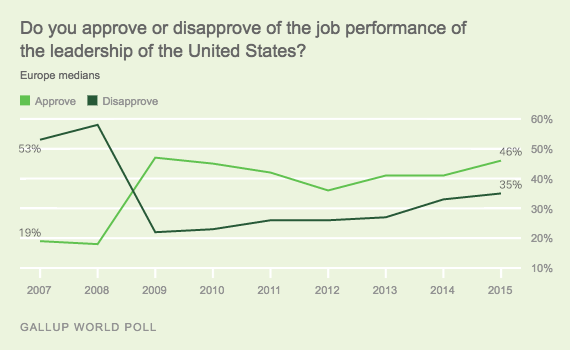
The U.S. achieved majority support in 15 European countries in 2015, including key allies such as France, Ireland, Italy and the United Kingdom. Kosovo led the region -- and the world -- in approval for the second consecutive year, with 85% approving of U.S. leadership. Russia and Belarus, of course, with two of the lowest approval ratings in the world, gave the lowest scores in the region.
Bottom Line
Regionally, approval ratings are still strongest in Africa, as they have been for the past decade, but approval remained mired at its lowest level in the history of Gallup's trend. Ratings in Asia also remained mostly unchanged from 2014 -- despite U.S. efforts to "pivot to Asia." The bright spots for U.S. leadership are Europe and the Americas, where ratings continue to improve. In Europe, ratings have almost rebounded to the levels at the beginning of the Obama administration.
Beyond 2016, the next president of the U.S. will continue to face even more challenges, making the strength of U.S. alliances and partnerships -- and the soft power of what the world thinks of the U.S. -- more important than ever.
The data in this article are available in Gallup Analytics.
Read the full 2016 U.S.-Global Leadership Report.
Survey Methods
Results are based on face-to-face and telephone interviews with approximately 1,000 adults, aged 15 and older, conducted throughout 2014 in 135 countries and 2015 in 132 countries. For results based on the total samples, margin of sampling error ranges from ±2.5 percentage points to ±5.2 percentage points at the 95% confidence level. The margin of error reflects the influence of data weighting. In addition to sampling error, question wording and practical difficulties in conducting surveys can introduce error or bias into the findings of public opinion polls.
With some exceptions, all samples are probability-based and nationally representative of the resident population aged 15 and older.
Exceptions include areas where the safety of interviewing staff is threatened, scarcely populated islands in some countries, and areas that interviewers can reach only by foot, animal or small boat.
